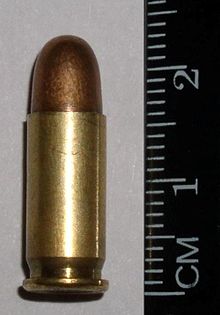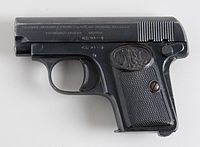.25 ACP
| .25 ACP | ||||||||||||||||
|---|---|---|---|---|---|---|---|---|---|---|---|---|---|---|---|---|
 .25 ACP cartridge with scale | ||||||||||||||||
| Type | Pistol | |||||||||||||||
| Place of origin | United States and Belgium | |||||||||||||||
| Production history | ||||||||||||||||
| Designer | John Browning | |||||||||||||||
| Designed | 1905 | |||||||||||||||
| Produced | 1905–present | |||||||||||||||
| Specifications | ||||||||||||||||
| Case type | Semi-rimmed, straight | |||||||||||||||
| Bullet diameter | .251 in (6.4 mm) | |||||||||||||||
| Neck diameter | .276 in (7.0 mm) | |||||||||||||||
| Base diameter | .278 in (7.1 mm) | |||||||||||||||
| Rim diameter | .302 in (7.7 mm) | |||||||||||||||
| Rim thickness | .043 in (1.1 mm) | |||||||||||||||
| Case length | .615 in (15.6 mm) | |||||||||||||||
| Overall length | .91 in (23 mm) | |||||||||||||||
| Rifling twist | 1:16 | |||||||||||||||
| Primer type | Small pistol | |||||||||||||||
| Maximum pressure | 25,000 psi (170 MPa) | |||||||||||||||
| Ballistic performance | ||||||||||||||||
| ||||||||||||||||
| Test barrel length: 2" Source(s): Guns & Ammo Magazine | ||||||||||||||||
The .25 ACP (Automatic Colt Pistol) (6.35×16mmSR) is a semi-rimmed, straight-walled centerfire pistol cartridge introduced by John Browning in 1905 alongside the Fabrique Nationale M1905 pistol.
Design
The cartridge is of semi-rimmed design meaning that the rim protrudes slightly beyond the diameter of the base of the cartridge so the cartridge can headspace on the rim.[1]
Though the .25 ACP was designed for semi-automatic pistols, various .25 ACP revolvers were produced in the early twentieth century by Belgian, French, and German gunmakers such as Adolph Frank and Decker.[2] In the late twentieth century, Bowen Classic Arms produced a custom Smith & Wesson revolver in .25 ACP.[3]
Performance
The use of the .25 ACP allows for a very compact lightweight gun, but the cartridge is relatively short-ranged and low-powered, putting it in the same class as the .22 LR rimfire cartridge but at a significantly higher cost. The .25 ACP is viewed by some as a better choice for personal defense handguns due to its centerfire-case design, which is inherently more reliable and more powerful than a .22 LR rimfire cartridge.[4]
-
FN 1905/6
-
Modern jacketed hollow point loads for 6.35mm/.25 cal.
-
The Walther Model 9 pistol uses 6.35mm
-
Raven MP-25 .25 ACP chrome with faux mother of pearl grips and push up safety
See also
- 6 mm caliber – Firearm cartridge classification
- Table of handgun and rifle cartridges
References
- ^ *Wilson, R. K. Textbook of Automatic Pistols. Plantersville, SC: Small Arms Technical Publishing Company, 1943. p. 258. ISBN 978-0-935632-89-7.
- ^ Hogg, Ian; Walter, John (2004-08-29). Pistols of the World. David & Charles. ISBN 0873494601.
- ^ Bowen, Hamilton. The Custom Revolver. Privately printed, 2001. ISBN 978-0-9713366-0-5.
- ^ Jerry Ahern (2010), Gun Digest Buyer's Guide to Concealed-Carry Handguns, Gun Digest Books, pp. 19–20, ISBN 978-1-4402-1383-0





